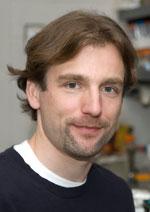
Brad Nolen
Education
B.A., Missouri State University,1997. M.S. University of California, San Diego, 1999. Ph.D., University of California, San Diego, 2003 (Gourisankar Ghosh). Postdoctoral: Yale University, 2003-2008 (Thomas D. Pollard). Honors and Awards: Ruth L. Kirschstein National Research Service Award, 2004; American Association for the Advancement of Science; Mass Media Fellowship, 2002; American Heart Association Postdoctoral Fellow, 2001; University of California, San Diego, Molecular Biophysics Training Grant 1998. Oregon start date Fall 2008.
Research
The Nolen lab is investigating the molecular basis for regulation of the cytoskeleton, the molecular framework that provides physical support for cells. One of our primary interests is actin, a highly conserved eukaryotic protein which polymerizes into two-stranded helical filaments. Rearrangements of the actin filament network are critical for cellular processes that require a change in cell shape, such as motility, uptake and release of materials and cell division. To regulate these processes, cells utilize a myriad of proteins to control polymerization, depolymerization, severing, capping and crosslinking of actin filaments.
Actin filaments are generated de novo by actin nucleator proteins, which bring the first few actin monomers together to form a template for filament elongation. Arp2/3 complex, a 225kD assembly of seven subunits (Arp3, Arp2, ARPC1-5) is one such nucleator. Arp2/3 complex is intrinsically inactive, and activation requires binding to an activator protein, such as a WASp/Scar family protein, and recruitment of the complex to the side of a pre-existing actin filament. Once activated, the complex nucleates the growth of a new filament which is anchored to the pre-existing filament at a 78% angle. This process results in the formation of tightly crosslinked, highly branched filament networks.
Arp2/3 complex is essential in the formation of invadopdia, cellular structures essential for the migration of tumor cells through the basal lamina into the blood stream. Invading bacterial and viral pathogens usurp Arp2/3 complex in host cells to escape detection by the immune system. Despite the biomedical importance of the complex, many fundamental questions about how it functions remain unanswered. For instance, how do activator proteins like WASp/Scar activate Arp2/3 complex? How is the proposed activating conformational change accomplished and how does this change promote formation of the filament nucleus?
We use a combination of biochemistry, biophysics, x-ray crystallography and molecular dynamics simulations to investigate these questions, and our ultimate goal is to understand how phenomena observed at the cellular level are controlled at the molecular level. Therefore, we are especially interested in experimental systems in which we can test our findings in vivo. Schizosaccharomyces pombe provides one such system, since it is genetically tractable, can be used for production of the large quantities of protein required for x-ray crystallography and is suitable for microscopy.
Publications
Peer-Reviewed Publications
Luan, Qing, Nolen BJ. (2013) Structural basis for regulation of Arp2/3 complex by GMF. Nature Structural & Molecular Biology. 2013 June 2013.
Hetrick B, Han MS, Helgeson LA, Nolen BJ. (2013) Small molecules CK-666 and CK-869 inhibit actin-related protein 2/3 complex by blocking an activating conformational change. Chem Biol. 2013 May 23;20(5):701-12
Liu SL, May JR, Helgeson LA, Nolen BJ. (2013) Insertions within the actin core of actin-related protein 3 (Arp3) modulate branching nucleation by Arp2/3 complex. J Biol Chem. 2013 Jan 4;288(1):487-97
Baggett AW, Cournia Z, Han MS, Patargias G, Glass AC, Liu SY, Nolen BJ. (2012) Structural characterization and computer-aided optimization of a small-molecule inhibitor of the Arp2/3 complex, a key regulator of the actin cytoskeleton. ChemMedChem. 2012 Jul;7(7):1286-94.
Liu SL, Needham KM, May JR, Nolen BJ. (2011) Mechanism of a concentration-dependent switch between activation and inhibition of Arp2/3 complex by coronin. J Biol Chem. 2011 May 13;286(19):17039-46. Epub 2011 Mar 21.
Nolen BJ, Tomasevic N, Russell A, Pierce DW, Jia Z, McCormick CD, Hartman J, Sakowicz R, Pollard TD. (2009) Characterization of two classes of small molecule inhibitors of Arp2/3 complex. Nature. 2009 Aug 20;460(7258):1031-4. Epub 2009 Aug 2.
Nolen, B.J. and Pollard, TD. (2008) Structure and biochemical properties of fission yeast Arp2/3 complex lacking the Arp2 subunit. J Biol Chem. 2008 Sep 26;283(39):26490-8. Epub 2008 Jul 18.
Dalhaimer, P.*, Pollard, T.D., and Nolen, B.J.* (2008) Nucleotide-mediated conformational changes of monomeric actin and Arp3 studied by molecular dynamics simulations. J. Mol. Bio.,376, 166-183.(*contributed equally to this work).
Nolen, B.J. and Pollard, T.D. (2007) Insights into the influence of nucleotides on actin family proteins from seven structures of Arp2/3 complex. Mol. Cell, 26, 449-57.
Nolen, B.J.*, Littlefield, R.S.*, and Pollard, T.D. (2004) Crystal structures of Arp2/3 complex with bound ATP or ADP. Proc. Natl. Acad. Sci. USA , 101, 15627-15632. (*contributed equally to this work).

